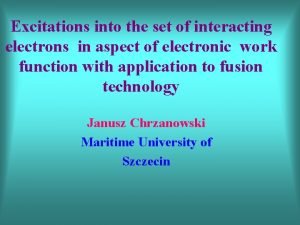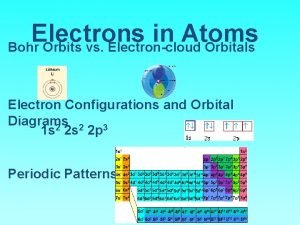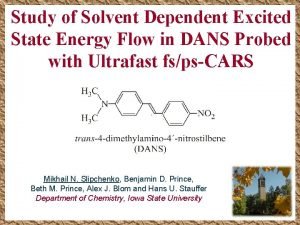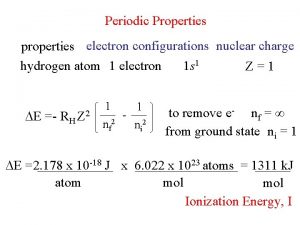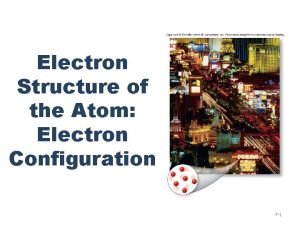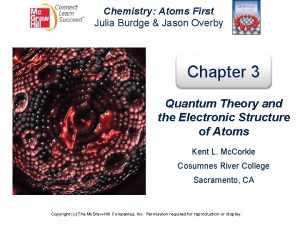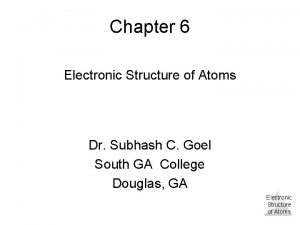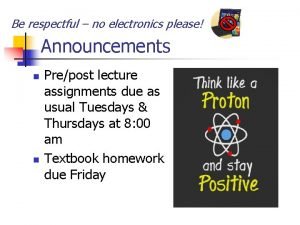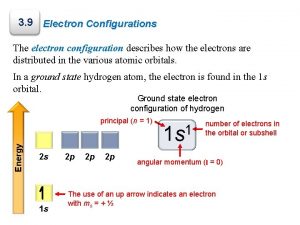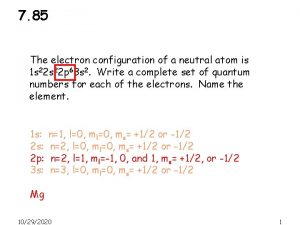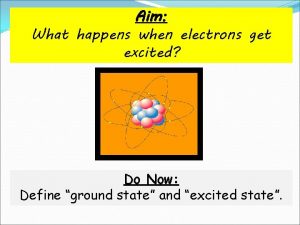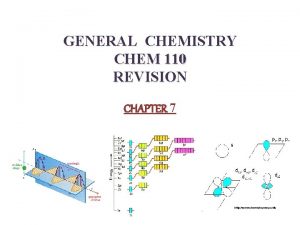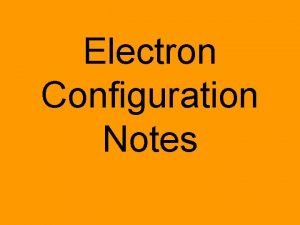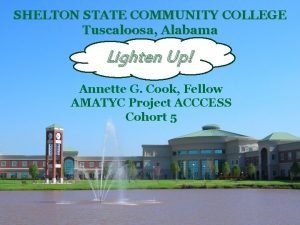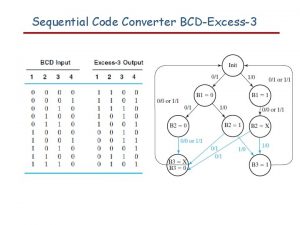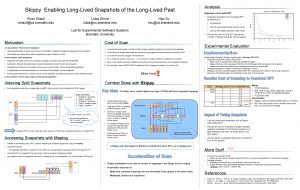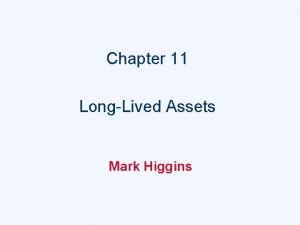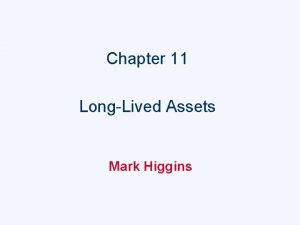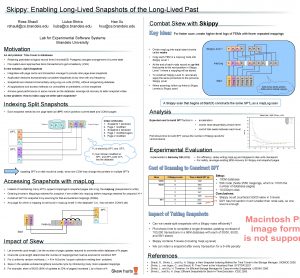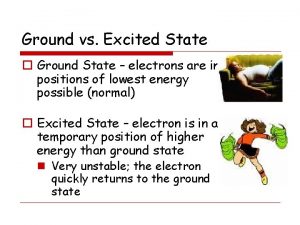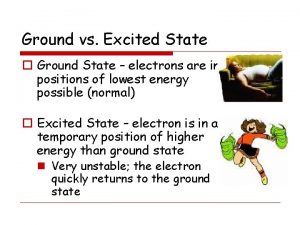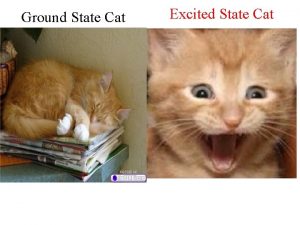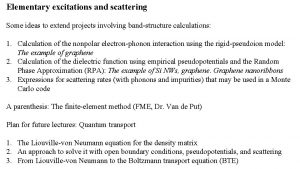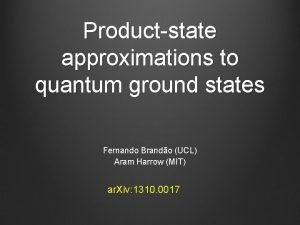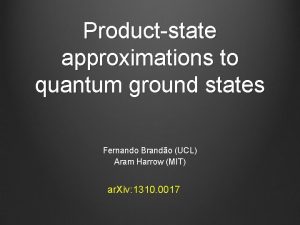Elementary Excitations longlived states near the ground state




































- Slides: 36

Elementary Excitations ~ long-lived states near the ground state. ( many body effects included ) Quasi-particles: band-electron, polaron, … (Fermions) Collective excitations: phonon, magnon, plasmon, polariton, … (Bosons) In between: Cooper pair, exciton, ….

14. Plasmons Polaritons and Polarons Dielectric Function of the Electron Gas Definitions of the Dielectric Function Plasma Optics Dispersion Relation for Electromagnetic Waves Transverse Optical Modes in a Plasma Transparency of Alkali Metals in the Ultraviolet Longitudinal Plasma Oscillations Plasmons Electrostatic Screening Screened Coulomb Potential Pseudopotential Component Mott Metal-Insulator Transition Screening and Phonons in Metals Polaritons LST Relation Electron-Electron Interaction Fermi Liquid Electron-Phonon interaction: Polarons Peierls Instability of Linear Metals

Dielectric Function of the Electron Gas ε(ω, 0) : plasmon ε(0, K) : screening Definitions of the Dielectric Function: Fourier components (ω dependence understood ): → → → →

Plasma Optics ( K 0 ) → Plasma frequency ωp is defined by Adding ion core constant contribution:

Dispersion Relation for Electromagnetic Waves In a non-magnetic isotropic medium: Plane wave solution: → Assuming ω real : ε real & ε > 0 → K real : trans. EM wave with vph = c / ε 1/2 ε real & ε < 0 → K imaginary : damped wave with depth 1 / K. ε complex → K complex : damped wave with depth 1 / Re(K). ε= spontaneous oscillation. ε=0 longitudinal plasma wave.

Transverse Optical Modes in a Plasma →

→ K 2<0 → incident wave totally reflected → transverse wave in plasma

Transparency of Alkali Metals in the Ultraviolet Metal reflects visble light but is transparent to ultraviolet light. In. Sb with n = 4 1018 cm– 3

Longitudinal Plasma Oscillations Condition for longitudinal mode: Reason: For a longitudinal wave, there is a depolarization field → K = 0 plasma wave in thin film

e gas: → ωp = low freq cut-off of transverse EM wave. Motion of a unit volume of e gas of concentration n : where → For small K, See J. M. Ziman, “Principles of the Theory of Solids”, 2 nd ed. , § 5. 7.

Plasmons Plasmon = quantum of plasma wave. (boson) Creation of plasmon in metal thin film by inelastic e scattering. Einc 10 ke. V spectrometer for plasmon

Al Mg Einc = 2 ke. V Harmonics of 10. 3 e. V (surface) & 15. 3 e. V (volume) losses Harmonics of 7. 1 e. V (surface) & 10. 6 e. V (volume) losses Prob. 1

Electrostatic Screening Ref: G. D. Mahan, “Many-Particle Physics, 2 nd ed. , § § 5. 4 -5 Static screening ε(0, K). Jellium model: uniform e gas of charge density – n 0 e with uniform background charge + n 0 e. Let background charge be disturbed (e. g. by impurities): Gauss’ law: Fourier components: Longitudinal component: → Isotropic medium: Linear screening:

Let T = 0. For φ = 0 For φ 0 K << k. F → →

= Bohr radius → 1 / k. S = Thomas-Fermi screening length For Cu with n 0 = 8. 5 1022 cm– 3 , k. S = 0. 55 A. → Limit not the same → Full theory for ε(ω, K) was due to Lindhard. (see Mahan § 5. 5. B)

Screened Coulomb Potential Consider a point charge q in an e gas. In the absence of the e-gas → Fourier transform: → By definition: Thomas-Fermi screening: → ( unscreened potential of q )

( contour closing in upper complex K plane ) Note: T-F screening is valid only for K << k. F. Friedel oscillations set in for large K. Calculations based on the screened potential for the residual resistivities of substitutional alloys of Cu with metallic elements of different valencies agreed well with experiment.

Pseudopotential Component In a metal of valency z and ion density n 0 : → →

Mott Metal-Insulator Transition Independent e model → c-H with 1 atom per primitive cell is a metal. c-H 2 with 1 molecule per primitive cell is an insulator. Under extreme pressure (equal inter- & intra- molecule H dist. ), c-H 2 becomes metallic. With e-e interaction considered, c-H at T = 0 may either be metallic or insulating depending on the lattice constant a. Mott: Critical lattice constant separating the metallic & insulating state is Ref: N. F. Mott, E. A. Davis, “Electronic Processes in Non-Crystalline Materials”, 2 nd ed. , § 4. 2. Each e sees a screened potential from each proton: n 0 = e density For very large k. S , there is no bound state → solid is metallic. Bound state 1 st appears when k. S < 1. 19 / a 0. → For a s. c. lattice, n 0 = 1/a 3. →

Mott (metal-insulator) transition can be caused by changes in composition, pressure, strain, Ba , … Metallic phase: independent e (band model). Insulator phase: strong e-e correlation (Hubbard model). Doping of semiconductor can also induce a metal-insulator transition. → Assuming P arranged in s. c. lattice: P in Si

Screening and Phonons in Metals phonon T-F ε for e → Longitudinal mode: → LA phonon Good agreement with experiment for alkali metals. E. g. , for K, vcalc = 1. 8 105 cm/s , vexp = 2. 2 105 cm/s along [100] at 4 K. Plasma: →

Polaritons TO phonon + photon → polariton Maxwell eqs with J = 0, =1 : → Plane wave solution: P due to TO phonon: P=Nqu Oscillatory solution: → → →

K=0: photon polariton → Including e contribution → →

→ LST relation → EM wave reflected Sr. F 2

ωL = ωLO ωT = ωTO forbidden gap Ga. P

LST Relation derived for s. c. lattice with 2 atoms in primitive cell Lydane-Sachs-Teller relation: Soft mode: ωTO = 0 ε(0) → (ferroelectric) partial propagation Na. Cl λTO = 61 10− 4 cm , λLO = 38 10− 4 cm p : film: |K| small Strong Absorption Li. F thin film on Ag 30。 incidence

neutron inelastic scattering

Electron-Electron Interaction e-e coulomb interaction → e-e scattering, inertial drag, … Fermi Liquid (Landau): Quasi-particle description of low-lying excited states. Q. P. = e + distorted e cloud m → m* For alkali metals, m* 1. 25 m.

Electron-Electron Collisions Puzzle: r. S ~ 2 A but l ~ 104 A for conduction e’s in metal. Reasons: 1. Exclusion principle. 2. Screening Forbided Allowed → Only fraction ε 1 /εF allowed T = 0: only (ε 1 /εF )2 10– 10 can scatter Only fraction ε 1 /εF allowed T 0:

Numerical calculations with screening → σ0 10– 15 cm 2 < unscreened Rutherford value At 300 K, → e-ph scattering dominates at room T. At l-He temperature, ρ ~ T 2 (e-e scattering dominant) For In at 2 K, l = 30 cm. →

Electron-Phonon Interaction: Polarons Effect of e-ph interaction: • ρ T, e. g. , for Cu, ρ = 1. 55 μΩ-cm at 0 C, ρ = 2. 28 μΩ-cm at 100 C. • m* > m ( polaron = e + strain field ). rigid lattice deformable lattice Polaron effect is strong in ionic, but weak in covalent, crystals.

e-ph coupling constant number of ph around a slow e. m*pol from cyclotron exp. Theory : Large polaron: band-like with m*. Small polaron: moves by ( thermally activated ) hopping. In polar crystal with degenerate band edge, e or more likely, h , can be self-trapped by inducing lattice deformation. Conductivity by Ag+ hopping in MAg 4 I 5 (M = K, Rb, NH 4 ) can have σ 105 that of typical ionic crystals

Peierls Instability of Linear Metals At T = 0, a 1 -D e gas is unstable w. r. t. static lattice deformation of G = 2 k. F. → energy gap created at εF. E. g. Ta. S 3. Equilibrium deformation Δ is given by For an elastic strain Δ cos 2 k. F x Let the lattice potential seen by e be → → for

for → → with

d. K/ = # of orbitals per unit length → →

For x >> 1, where c. f. BCS gap
 Threshold frequency
Threshold frequency Full orbital diagram for he
Full orbital diagram for he Seahawks tackling drills
Seahawks tackling drills What were the 11 free states
What were the 11 free states Southern states
Southern states Tyranny
Tyranny Ground vs excited state
Ground vs excited state Zeff of h-
Zeff of h- 1s1 electron configuration
1s1 electron configuration Ground state electron configuration of arsenic
Ground state electron configuration of arsenic Ground state of arsenic
Ground state of arsenic Sulfur ground state electron configuration
Sulfur ground state electron configuration What are electron configurations
What are electron configurations Electron configuration of o+
Electron configuration of o+ What happens when electrons get excited
What happens when electrons get excited Impossible electron configuration
Impossible electron configuration Lowest energy configuration
Lowest energy configuration Mathmaticious
Mathmaticious Hemmingway place state college
Hemmingway place state college Nagc state of the states
Nagc state of the states Which two states are equivalent state
Which two states are equivalent state Hát kết hợp bộ gõ cơ thể
Hát kết hợp bộ gõ cơ thể Ng-html
Ng-html Bổ thể
Bổ thể Tỉ lệ cơ thể trẻ em
Tỉ lệ cơ thể trẻ em Voi kéo gỗ như thế nào
Voi kéo gỗ như thế nào Glasgow thang điểm
Glasgow thang điểm Hát lên người ơi alleluia
Hát lên người ơi alleluia Các môn thể thao bắt đầu bằng tiếng nhảy
Các môn thể thao bắt đầu bằng tiếng nhảy Thế nào là hệ số cao nhất
Thế nào là hệ số cao nhất Các châu lục và đại dương trên thế giới
Các châu lục và đại dương trên thế giới Cong thức tính động năng
Cong thức tính động năng Trời xanh đây là của chúng ta thể thơ
Trời xanh đây là của chúng ta thể thơ Cách giải mật thư tọa độ
Cách giải mật thư tọa độ Làm thế nào để 102-1=99
Làm thế nào để 102-1=99 độ dài liên kết
độ dài liên kết Các châu lục và đại dương trên thế giới
Các châu lục và đại dương trên thế giới
